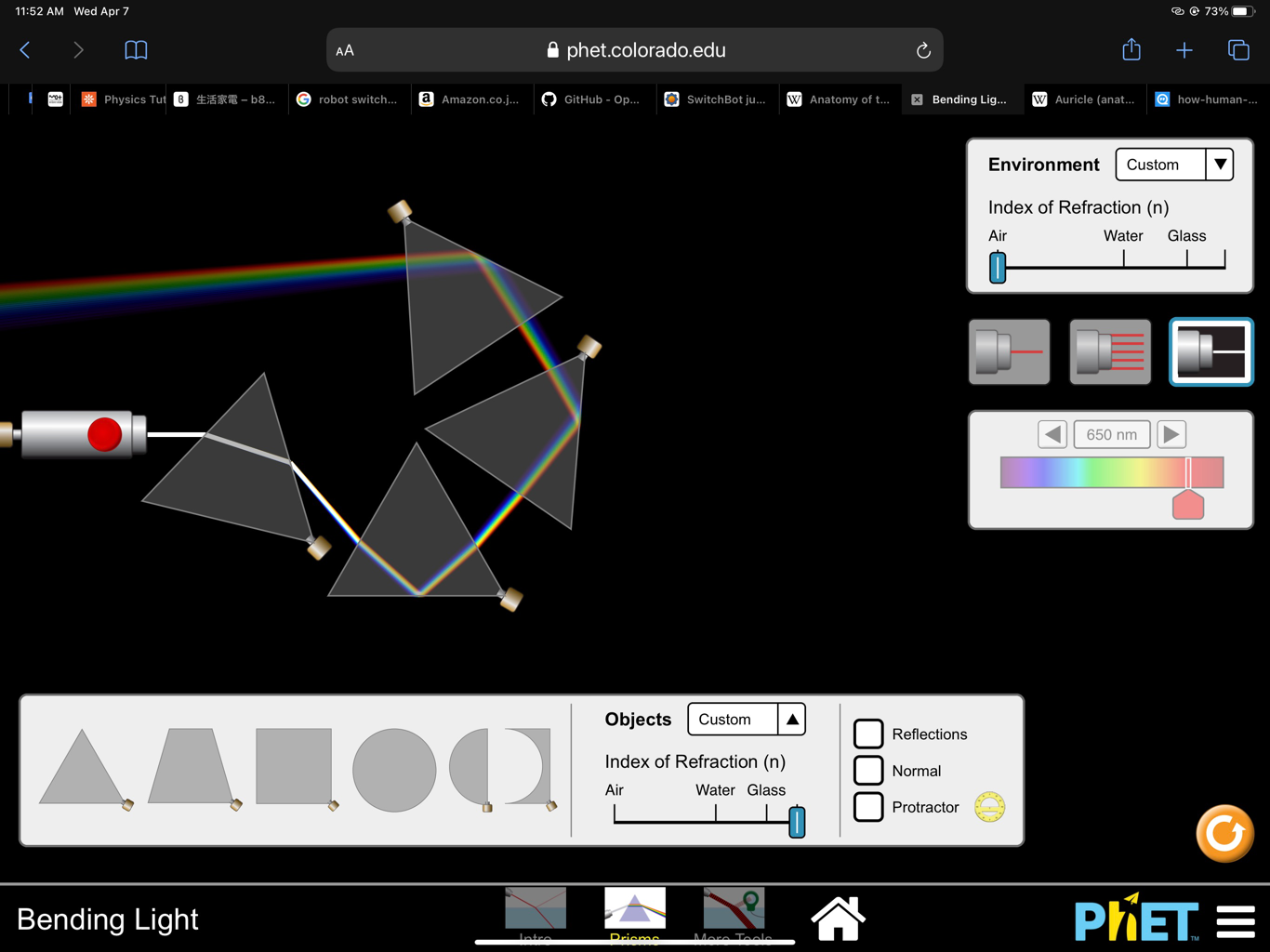Run the Ripple Tank simulator, by Paul Falstad.
- Choose “Example: Refraction” set-up (preset). The finite length line source (in top left of tank) creates wavefronts that have some shape between planes (for long generators) and circles (for point-shaped generators).
- Adjust the length of the source to confirm this. (Assert “Stopped” to pause the simulation, click “Clear Waves” to reset the simulation, move either end of the line source to shorten it [select the source by clicking it, then drag either end], and toggle “Stopped” to restart the simulation.)
- Observe bending of wave when passing from one medium to another. Pulses of a monotonic (single frequency) wave “pull into” medium of higher density (like tendency of vehicles to pull into rough gravel of road shoulder). Note that this phenomenon applies not only to visible light and near spectrum “light (UV [ultraviolet; 紫外線] ↔ IR [infrared; 赤外線]”) phenomena, but also to sound, which is why acoustic waves bend into cooler air.
- Optional: enable 3-D View for projective perspective instead of orthographic display, inclding adjusting viewpoint by dragging display.
- Try the “Example: Single Slit”, “Example: Double Slit”, & “Example: Triple Slit” presets to observe how changing the source frequency changes the angles of difraction.
This behavior is captured by Snell's Law: sin θ2/sin θ1 = v2/v1 = n1/n2, where θ2 is the angle of incidence, θ1 is the angle of refraction, v2 is the speed of the wave in the incident medium, v1 is the speed of the wave in the transmission medium, n1=c/v1 is the index of refraction of the incident medium, and n2=c/v2 is the index of refraction of the transmission medium.
Typical refractive indices for yellow light (wavelength equal to 589 nm [10−9 meter]) are the following:
- vacuum: 1.0000
- air: 1.0003
- water: 1.333
- crown glass: 1.517
- dense flint glass: 1.655
- diamond: 2.417.
Run the PhET “Bending Light”; 「光の屈折」demo (also available in other languages, including Mandarin Chinese, Traditional Chinese, ...)
- Choose first activity, “Intro.[duction]”;「光の屈折 」. Project light across media of different Indices of Refraction. Observe reflection and transmission, and conservation of energy such that total power is constant. (Use power meter to measure intensity of incident, reflected, and transmitted beams.) Use Snell’s Law to determine the Index of Refraction of “Mystery Material #1” and corresponding speed of light through that medium.
-

Choose second activity, “Prisms”;「プリズム」. Arrange a triangular prism in front of monochromatic light source. Observe bending angle changing depending on frequency and wavelength due to refraction. Change light source to white light. Observe rainbow spectrum due to dispersion. Leaving the enviromental index of refraction at a minimum, maximize the index of refraction for the prism. Compose a series of prisms to broaden the rainbow.
- Assert “Grating in Place” to simulate diffraction grating.
- Observe that changing the wavelength (and hence frequency) of the incident light changes the diffraction (bending) through the grating.
Reference links:
- Chromastereopsis
- Chromatek & Chromastereopsis: Chromadepth 3D
- Chromadepth 3D Design Guide
- University of Aizu Exhibition ChromaDepth Picture Contest: E: 英語, J: 日本語
- University of Aizu Chromadepth Picture Contest galleries
- Wikipedia: ChromaDepth
- OSU ChromaDepth Scientific Visualization Gallery
- Brain Factory 3D chromadepth video (10 s.)
- Michael Bailey & Dru Clark, “Using ChromaDepth to obtain Inexpensive Single-image Stereovision for Scientific Visualization,” J. of Graphics Tools, 3(3), Aug. 1999, pp. 1-9.
- Chromostereopsis demo, Michael Bach
- “Chromostereopsis: Advancing color and receding color,” Akitaoka Kitaoka; 北岡 明佳
- Chromatic Depth Phenomena
- 3-D Vision with ChromaDepth Glasses, by Christian Ucke, ICPE/GIREP (International Group on Physics Teaching) Conf. ‘Hands-On Experiments in Physics Education’ Aug., 1998, Duisburg, Germany, January 1999
- Photopea (online image editor) (link to bilingual version by Hoshino Yusui; 星野 結水)
- Color Vision; 光の色: Color Vision; 光の色
- How the Human Eye Works: Click (blue [off] ⥨ green [on]) the 360 ↺ icons to toggle inspection mode (rotatability).
maintained by Michael Cohen
